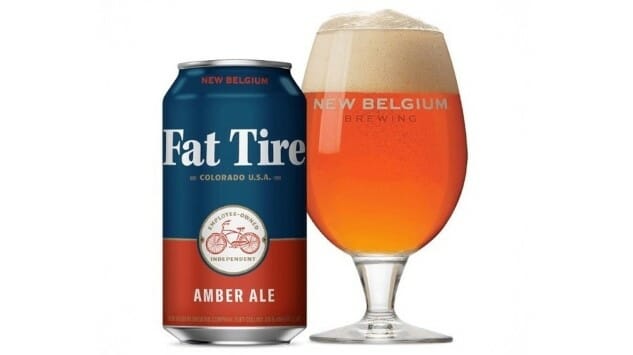My Month of Flagships: New Belgium Brewing Fat Tire
Photos via New Belgium Brewing Co.,
This essay is part of a series this month, coinciding with the concept of Flagship February, wherein we intend to revisit the flagship beers of regional craft breweries, reflect on their influence within the beer scene, and assess how those beers fit into the modern beer world. Click here to see all the other entries in the series.
There’s no denying that classic amber ales have had a rough go of it in the modern craft beer landscape. As we’ve expounded on in the past, this is a style that was once completely ubiquitous among American breweries—before the mid-2000s, you could reliably make the assumption that almost any distributing brewery (and especially brewpubs) was going to have a non-adjunct amber or red ale on tap, just as assuredly as they would have a pale ale or porter/stout. For both drinkers and brewers, they were one of the safest plays that existed in craft beer, but as tastes moved away from seeking balance, amber ale flagships tended to feel the pinch.
In some cases (as in another beer in this series, Alaskan Amber Ale), the flagship endured despite hardships as the face of its company. In other cases, as at Bell’s Brewery, the flagship amber ale gave way to a new flagship (Two Hearted Ale), settling into a less lofty place in the company’s portfolio. But what happens when the amber ale is synonymous with the entire brewery? Well, that was the case for New Belgium Brewing Co. and the venerable Fat Tire.
Fat Tire, as if it needs saying, is the beer that built New Belgium into one of the country’s largest craft breweries—#4 in the country according to the Brewers Association definition, prior to their sale to Kirin-owned Lion Little World Beverages at the end of 2019. First brewed in 1991, its branding and bicycle imagery were so successful and iconic that an entire generation of beer drinkers grew up with probably more awareness of the “Fat Tire” brand than New Belgium itself. I certainly remember entire years of drinking it in college bars in mid-2000s Illinois, surrounded by people who thought it was a product from the nonexistent “Fat Tire Brewery.” It informed the look and feel of every other New Belgium product, even in collaborations such as the Fat Tire & Friends sampler box.
That somehow feels fitting for Fat Tire, though, because despite its popularity and status as a gateway beer for so many first-time craft beer drinkers over the decades, it always seemed to be surrounded by misconceptions. Chief among them was the idea that Fat Tire was a “Belgian amber ale,” presumably due to New Belgium’s roots in the Belgian brewing tradition. In reality, Fat Tire was never a “Belgian ale”—it was always made with clean-fermenting American ale yeast, and homebrew clone kits are sold with neutral American ale yeast to this day. It’s perhaps best described by the company’s media relations director at the time in a 2013 profile, wherein he said the following:
“Fat Tire won over fans with its sense of balance—toasty, biscuit-like malt flavors and hoppy freshness,” explained Bryan Simpson, media relations director at New Belgium. “We try to emphasize moderation and balance. We feel that amber ales should not be overly malty, hoppy, bitter, alcoholic or sweet.”
That quote, however, also captures exactly why it became so much harder in the 2010s to continue selling a beer that had never declined in quality: If craft-curious beer drinkers were originally drawn to Fat Tire for its “sense of balance,” then those same drinkers today have increasingly conditioned themselves to seek out anything but. When every hype style in the beer world encourages extremes of flavor, you’re almost better off being “overly” malty, hoppy, bitter, alcoholic or sweet. And of course, competing against more than 8,000 other breweries in 2020 doesn’t exactly help either.
-

-

-

-

-

-

-

-

-

-

-

-

-

-

-

-

-

-

-

-

-

-

-

-

-

-

-

-

-

-

-

-

-

-

-

-

-

-

-

-








































